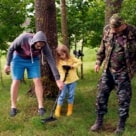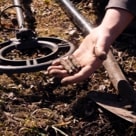Metal Detecting on the Beach
Published by Carolyn Yohannes on 05/17/17
Summer is coming and the warmer weather is perfect for metal detecting on the beach. You won’t find too many relics or rare coins on the beach, but the draw of finding lost silver or gold jewelry is every bit as exciting.
The following are some tips and tricks that will make your beach hunting more productive and fun.
Hunting on Dry Sand
When you are searching in dry sand, you’ll find that it is very much like hunting in very sandy soil that is away from the water, except that you’ll find a lot more trash. This means that you may have to work a little bit harder and dig some trash, but with some practice you’ll be able to differentiate pieces of foil from jewelry based on your detector’s alerts. Some of the hunting hot spots in the dry sand are:
- Towel lines – Typically, people on the beach follow each other’s lead and lay their towels down in a line along the shore. Look for sections of the “towel line” that are empty and search those areas. Be careful to not irritate the sunbathers — you don’t want to be that guy.
- Areas of activity – The best places to hunt are where people are gathered (or were gathered). For that reason, it’s a good idea to hunt around picnic areas and refreshment stands where items may have been dropped. If there are beach volleyball areas and lifeguard stations, those are great sites as well.
- Shady areas – In the heat of the summer, beach goers will look for shade. Hunt in areas where piers or large rocks provide afternoon shade; people have likely spent some time there.
Hunting in Wet Sand
As the high tide recedes, search closer to and in the shallow water areas with wet sand. This is a little bit more difficult because salt water can cause some fluctuation in background conditions. That means you’ll have to make frequent ground balance adjustments or use a multi-frequency detector that can automatically ground balance. You may want to use a smaller coil for searching in the shallow water so that you don’t tire out from the drag of the water. Wet sand provides some optimum hunting areas including:
- Eroded areas – You want to be able to hunt as deeply as possible, so look for areas where the water or the wind has eroded the beach.
- Scallops in the sand – Dips that are perpendicular to the incoming waves are called “scallops” and they are great places to hunt.
- Pockets of shells and debris – Look closely at the areas where you see shells or other debris collecting. If the water has pushed a collection of shells and other stuff into a small area, it may have also pushed up some good items.
Things to Remember When Hunting on the Beach
Never forget your metal detecting etiquette. When you hunt on the beach, in wet or dry sand, be mindful of the people around you and don’t be annoying. Also, keep in mind that as you are searching around people, the items you find close to the surface may very well belong to the people they are near. Be respectful and return lost property if you know who the owner is.

